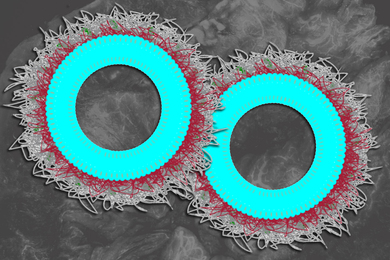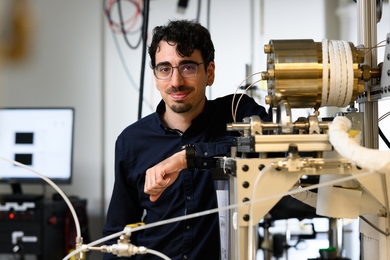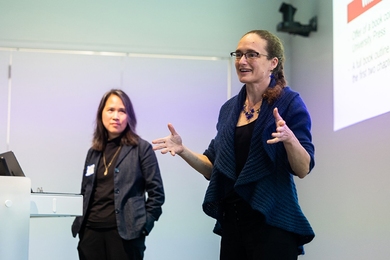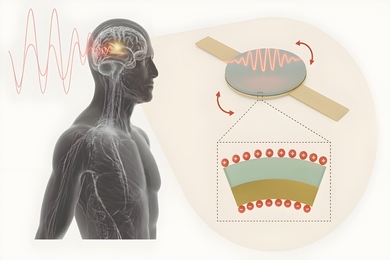For humans, the very idea of communication is bound up with the idea of language. But for hundreds of thousands of years before language emerged, we communicated the same way other social species do: through a complex system of nonverbal signals. We ignore those ancient signals at our peril, says Alex "Sandy" Pentland PhD '82 the Toshiba Professor of Media Arts and Sciences. Nonverbal cues can make unreasonable arguments strangely persuasive, but if properly recognized and harnessed, they can make group discussions much more productive.
Pentland's research group, the Human Dynamics Lab, tends to court contradictions. To study ancient signaling systems, it uses cutting-edge technology. But one of its recent findings is that even in an age of Twitter and texting, companies may improve their productivity if they give employees more time to talk face to face.
Pentland's MIT doctorate is in psychology, but after graduation, he immediately began applying psychological insight to artificial-intelligence research. After five years in Palo Alto, at Stanford University and SRI International, he came back to MIT as an expert in computer vision. His work expanded to include sensor systems more generally, and in 1997, Newsweek named him one of 100 people to watch in the new century for his work on "smart rooms" studded with sensors that could anticipate and meet their inhabitants' needs.
Pentland's early work also landed him on the boards of several startup companies, and it was there that he began to recognize the surprising power of primal signaling. "People were just behaving completely irrationally," he says. "But these are brilliant people. They're not dumb at all. So you say, Well, what's going on?" Pentland himself seems to have mastered some of the techniques of nonverbal communication that his lab studies. Leaning back comfortably on the couch in his office, he speaks enthusiastically but not anxiously, with the regular changes of pitch, the little conspiratorial asides, that immediately engage his interlocutor and inspire trust. "So I started looking at, for instance, charisma," he says. "How can people say things that are very convincing when in fact the facts aren't in the words? People just believe them because of the way they say it."
In the late 1990s, to get a quantitative handle on the nonverbal cues that seem to make people more or less convincing in conversation, Pentland's group developed "sociometers," which could be worn around the neck or fastened to clothing. Approximately as big as a deck of cards, these sensors contained accelerometers to gauge the wearers' physical movements, a microphone that could capture vocal inflections, and infrared transmitters and receivers that would register when two people wearing the devices came face to face. By analyzing data from sociometers worn by hundreds of volunteers in dozens of settings, the researchers discovered patterns that represent the degree of engagement between conversing people. For example, energy — lots of hand gestures — and variety of vocal inflection indicate enthusiasm; mimicking the gestures of another person was a very reliable sign of careful attention and growing trust. By looking for such patterns without assessing the content of the conversations, Pentland's group could predict, with 70 to 80 percent accuracy, whether, say, people meeting at a speed-dating event would exchange phone numbers, or whether attendees at a business meeting would exchange cards. Pentland describes these experiments in his 2008 book Honest Signals.
In recent years, his group has begun to use sociometers to analyze communication at organizations ranging from a German bank to a U.S. military installation. The striking conclusion is that unstructured face-to-face conversation — not formal meetings — seems to be a highly efficient means of propagating information that can increase worker productivity.
One recent experiment led by graduate student Benjamin Waber, for instance, involved the customer-support center for a major bank. "The way they were managing this call center, they discouraged face-to-face communication," Pentland says. "Their attitude was that that was distracting to people. So when they gave coffee breaks, they did it in a staggered way." The sociometer data indicated, however, that employees who nonetheless found a way to interact regularly with each other, forming dense communication networks in which everyone spoke to everyone else, were more productive than their less social colleagues. So Pentland's group suggested that the company let employees take breaks in groups. Average call time per customer went down, boosting productivity significantly and saving the company millions of dollars. And while customer satisfaction remained stable, those productivity gains reduced employees' stress levels, resulting in less turnover.
Employees on their breaks were not giving each other PowerPoint presentations about operations research; they were just gossiping. "But what is gossip?" Pentland says. "Gossip is stories about what happened and what you did. So in other words, they're trading tacit information. 'I had this guy call up and he was so mad, and I ...'"
The army's Battle Command Battle Lab at Fort Leavenworth, Kansas, recently concluded a two-week experiment using the sociometers. "In our laboratory here we can monitor systems easily enough — telephones, who calls who, e-mails, chat systems, all of that — so we measure a lot of that sort of data," says Brett Burland, the lab's chief of science and technology. "But we've never been able to capture face-to-face interactions before. The badge that [Pentland] developed really generated some interesting data for us."
Burland suggests how this information could help the army. "Let's say that you are sensing that you have a problem with intelligence and targeting," he says — where "targeting" might mean identification of an enemy radio frequency that the army wants to jam. "Is the problem that you're not collecting the intelligence you need, or is the problem that you're getting the information that you need to conduct adequate targeting, but you're not communicating it effectively in the process?" Data about face-to-face communication patterns, he says, "would help you to figure out where the disconnect is."
Pentland says that increased face-to-face communication also brought about productivity gains at the German bank, at an IT consulting firm, and even at MIT labs and research centers. "If you think about what needs to happen for a healthy organization," he says, "people need to know the rules of the road. They need to know how things are done. Which means they have to hear the stories; they have to interact with people. Because you tend not to do that over e-mail, or blogs, or things like that." Indeed, in some cases the rules of the road may be too controversial to commit to type. "Treating different types of people differently may yield greater productivity," he says. "But it's dangerous to make a hard-and-fast written rule, because that encourages stereotyping."
Sharing this type of unofficial knowledge is what Pentland calls information integration, which he distinguishes from the acquisition of new information. The same distinction, he says, can be seen in bees. A bee colony planning to move its hive will dispatch scouts to look for promising locations. When the scouts return, they perform dances that describe their findings: this is the influx of new information. The enthusiasm of the dance indicates the scout's confidence in the quality of the location — much the way the enthusiasm of charismatic board members can, sometimes misleadingly, indicate their confidence that they're right. On the basis of the dances, the scouts fly out in ad hoc groups to inspect the proposed locations until a sufficient number of scouts signal the same location, leading the colony to make its move: this is information integration.
Both types of information flow, Pentland argues, are crucial to an organization's success, but they're fostered in different ways. Internet connections and journal subscriptions are valuable sources of new information; but information integration depends on density of communication — which, within an organization, often means talking face to face. The recognition of that distinction was named one of Harvard Business Review's 20 "breakthrough ideas" for 2009.
Indeed, the manner in which different types of information propagate through social networks has become one of the Human Dynamics Lab's chief research topics, one that Pentland sometimes describes as the epidemiology of ideas. In a series of experiments at MIT done with Anmol Madan SM '05, PhD '10 for instance, students agreed to let their cell phones serve as continuously active location detectors, so that the lab could monitor whom they came in contact with and for how long. The students also filled out periodic surveys that gauged things like their political attitudes and dietary habits, and they supplied lists of their friends and most frequent conversation partners. Surprisingly, changes in people's political views seemed to have very little to do with the views of their closest friends, or with the views of anyone else with whom they frequently discussed politics. But changes were strongly correlated with the general attitudes of people in the subjects' immediate environment. The same went for eating habits and weight gain.
"That's this tacit, habitual, older type of thinking," Pentland says. "A way to describe it is, 'What's your impression of what everybody else is doing?'" For instance, he says, "if everybody where you live, or everybody where you hang out, always gets that third slice of pizza, even if your friends don't, you'll tend to."
By using cell-phone data, researchers including postdoctoral associate Manuel Cebrian and Nathan Eagle PhD '05 have been able to study the propagation of information on an even larger scale. Cell-phone companies have provided the lab with anonymized information about call patterns for entire cities, and Pentland says analysis of the data mirrors the results of the organizational studies using sociometers. Communities with frequent phone calls both inside and outside the area tend to have higher per-capita gross domestic products and better Gini coefficients (a measure of income equality). This suggests that they depend on both information acquisition and information integration. It seems that economists and city planners, no less than managers of large organizations, could still learn a thing or two from the bees.
This story also ran in the MIT News section of the Nov/Dec 2010 issue of Technology Review.
Pentland's research group, the Human Dynamics Lab, tends to court contradictions. To study ancient signaling systems, it uses cutting-edge technology. But one of its recent findings is that even in an age of Twitter and texting, companies may improve their productivity if they give employees more time to talk face to face.
Pentland's MIT doctorate is in psychology, but after graduation, he immediately began applying psychological insight to artificial-intelligence research. After five years in Palo Alto, at Stanford University and SRI International, he came back to MIT as an expert in computer vision. His work expanded to include sensor systems more generally, and in 1997, Newsweek named him one of 100 people to watch in the new century for his work on "smart rooms" studded with sensors that could anticipate and meet their inhabitants' needs.
Pentland's early work also landed him on the boards of several startup companies, and it was there that he began to recognize the surprising power of primal signaling. "People were just behaving completely irrationally," he says. "But these are brilliant people. They're not dumb at all. So you say, Well, what's going on?" Pentland himself seems to have mastered some of the techniques of nonverbal communication that his lab studies. Leaning back comfortably on the couch in his office, he speaks enthusiastically but not anxiously, with the regular changes of pitch, the little conspiratorial asides, that immediately engage his interlocutor and inspire trust. "So I started looking at, for instance, charisma," he says. "How can people say things that are very convincing when in fact the facts aren't in the words? People just believe them because of the way they say it."
In the late 1990s, to get a quantitative handle on the nonverbal cues that seem to make people more or less convincing in conversation, Pentland's group developed "sociometers," which could be worn around the neck or fastened to clothing. Approximately as big as a deck of cards, these sensors contained accelerometers to gauge the wearers' physical movements, a microphone that could capture vocal inflections, and infrared transmitters and receivers that would register when two people wearing the devices came face to face. By analyzing data from sociometers worn by hundreds of volunteers in dozens of settings, the researchers discovered patterns that represent the degree of engagement between conversing people. For example, energy — lots of hand gestures — and variety of vocal inflection indicate enthusiasm; mimicking the gestures of another person was a very reliable sign of careful attention and growing trust. By looking for such patterns without assessing the content of the conversations, Pentland's group could predict, with 70 to 80 percent accuracy, whether, say, people meeting at a speed-dating event would exchange phone numbers, or whether attendees at a business meeting would exchange cards. Pentland describes these experiments in his 2008 book Honest Signals.
In recent years, his group has begun to use sociometers to analyze communication at organizations ranging from a German bank to a U.S. military installation. The striking conclusion is that unstructured face-to-face conversation — not formal meetings — seems to be a highly efficient means of propagating information that can increase worker productivity.
One recent experiment led by graduate student Benjamin Waber, for instance, involved the customer-support center for a major bank. "The way they were managing this call center, they discouraged face-to-face communication," Pentland says. "Their attitude was that that was distracting to people. So when they gave coffee breaks, they did it in a staggered way." The sociometer data indicated, however, that employees who nonetheless found a way to interact regularly with each other, forming dense communication networks in which everyone spoke to everyone else, were more productive than their less social colleagues. So Pentland's group suggested that the company let employees take breaks in groups. Average call time per customer went down, boosting productivity significantly and saving the company millions of dollars. And while customer satisfaction remained stable, those productivity gains reduced employees' stress levels, resulting in less turnover.
Employees on their breaks were not giving each other PowerPoint presentations about operations research; they were just gossiping. "But what is gossip?" Pentland says. "Gossip is stories about what happened and what you did. So in other words, they're trading tacit information. 'I had this guy call up and he was so mad, and I ...'"
The army's Battle Command Battle Lab at Fort Leavenworth, Kansas, recently concluded a two-week experiment using the sociometers. "In our laboratory here we can monitor systems easily enough — telephones, who calls who, e-mails, chat systems, all of that — so we measure a lot of that sort of data," says Brett Burland, the lab's chief of science and technology. "But we've never been able to capture face-to-face interactions before. The badge that [Pentland] developed really generated some interesting data for us."
Burland suggests how this information could help the army. "Let's say that you are sensing that you have a problem with intelligence and targeting," he says — where "targeting" might mean identification of an enemy radio frequency that the army wants to jam. "Is the problem that you're not collecting the intelligence you need, or is the problem that you're getting the information that you need to conduct adequate targeting, but you're not communicating it effectively in the process?" Data about face-to-face communication patterns, he says, "would help you to figure out where the disconnect is."
Pentland says that increased face-to-face communication also brought about productivity gains at the German bank, at an IT consulting firm, and even at MIT labs and research centers. "If you think about what needs to happen for a healthy organization," he says, "people need to know the rules of the road. They need to know how things are done. Which means they have to hear the stories; they have to interact with people. Because you tend not to do that over e-mail, or blogs, or things like that." Indeed, in some cases the rules of the road may be too controversial to commit to type. "Treating different types of people differently may yield greater productivity," he says. "But it's dangerous to make a hard-and-fast written rule, because that encourages stereotyping."
Sharing this type of unofficial knowledge is what Pentland calls information integration, which he distinguishes from the acquisition of new information. The same distinction, he says, can be seen in bees. A bee colony planning to move its hive will dispatch scouts to look for promising locations. When the scouts return, they perform dances that describe their findings: this is the influx of new information. The enthusiasm of the dance indicates the scout's confidence in the quality of the location — much the way the enthusiasm of charismatic board members can, sometimes misleadingly, indicate their confidence that they're right. On the basis of the dances, the scouts fly out in ad hoc groups to inspect the proposed locations until a sufficient number of scouts signal the same location, leading the colony to make its move: this is information integration.
Both types of information flow, Pentland argues, are crucial to an organization's success, but they're fostered in different ways. Internet connections and journal subscriptions are valuable sources of new information; but information integration depends on density of communication — which, within an organization, often means talking face to face. The recognition of that distinction was named one of Harvard Business Review's 20 "breakthrough ideas" for 2009.
Indeed, the manner in which different types of information propagate through social networks has become one of the Human Dynamics Lab's chief research topics, one that Pentland sometimes describes as the epidemiology of ideas. In a series of experiments at MIT done with Anmol Madan SM '05, PhD '10 for instance, students agreed to let their cell phones serve as continuously active location detectors, so that the lab could monitor whom they came in contact with and for how long. The students also filled out periodic surveys that gauged things like their political attitudes and dietary habits, and they supplied lists of their friends and most frequent conversation partners. Surprisingly, changes in people's political views seemed to have very little to do with the views of their closest friends, or with the views of anyone else with whom they frequently discussed politics. But changes were strongly correlated with the general attitudes of people in the subjects' immediate environment. The same went for eating habits and weight gain.
"That's this tacit, habitual, older type of thinking," Pentland says. "A way to describe it is, 'What's your impression of what everybody else is doing?'" For instance, he says, "if everybody where you live, or everybody where you hang out, always gets that third slice of pizza, even if your friends don't, you'll tend to."
By using cell-phone data, researchers including postdoctoral associate Manuel Cebrian and Nathan Eagle PhD '05 have been able to study the propagation of information on an even larger scale. Cell-phone companies have provided the lab with anonymized information about call patterns for entire cities, and Pentland says analysis of the data mirrors the results of the organizational studies using sociometers. Communities with frequent phone calls both inside and outside the area tend to have higher per-capita gross domestic products and better Gini coefficients (a measure of income equality). This suggests that they depend on both information acquisition and information integration. It seems that economists and city planners, no less than managers of large organizations, could still learn a thing or two from the bees.
This story also ran in the MIT News section of the Nov/Dec 2010 issue of Technology Review.







